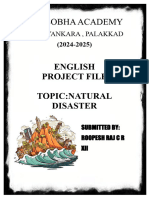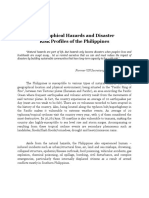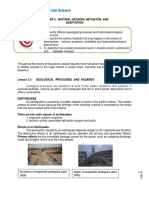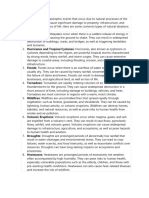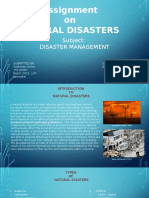Iclex DRR
Iclex DRR
Uploaded by
MAYUMI JENEL BADIONCopyright:
Available Formats
Iclex DRR
Iclex DRR
Uploaded by
MAYUMI JENEL BADIONOriginal Title
Copyright
Available Formats
Share this document
Did you find this document useful?
Is this content inappropriate?
Copyright:
Available Formats
Iclex DRR
Iclex DRR
Uploaded by
MAYUMI JENEL BADIONCopyright:
Available Formats
Badion, Mayumi Jenel S.
12STEM-15
ICLEX Activity
1. Watch the video “World’s Most shocking Natural Disasters”
2. Answer the following:
a. What are the different hazards shown in the video?
The video I viewed comprehensively presented various natural hazards
spanning the domains of geophysics, hydrology, and climate. Noteworthy instances
featured storm surges and floods in Mexico, hurricanes in Puerto Rico, earthquakes in
Mount Everest, China, tornadoes in the Philippines, landslides in China, earthquakes
in Greece and Turkey, tsunamis in Jackson, United States, tornadoes in Central
Louisiana and San Francisco, sunken pavement landslides, and sinkholes in Southern
California. Additionally, the video highlighted a significant seismic event - a 6.1
magnitude earthquake - that triggered a mudslide in Indonesia, and lastly, a sinkhole
occurrence in Turkey.
These diverse hazards underscore the global nature of natural disasters and their
potential to impact various regions. Each hazard depicted in the video poses unique
threats to the affected areas, ranging from immediate dangers such as loss of life and
infrastructure damage to long-term consequences like displacement and economic
setbacks. The inclusion of specific incidents, such as the earthquake in Mount Everest
and the sinkhole in Turkey, serves to emphasize the far-reaching and indiscriminate
nature of these natural phenomena. It is crucial to recognize the implications of these
hazards not only in terms of immediate devastation but also in the subsequent
challenges faced by communities as they strive to recover and rebuild in the aftermath
of such calamities.
b. Which of the hazards shown occurs in the Philippines?
The Philippines is situated within the Pacific Ring of Fire which evidently faces
a spectrum of natural disasters that significantly impact its landscape and
communities.
1. Typhoons – a prevalent hazard during the June to November season,
unleash strong winds, heavy rainfall, and storm surges, causing floods,
landslides, and extensive damage to infrastructure and agriculture.
2. Earthquakes – The seismic activity in the Pacific Ring of Fire exposes the
country to earthquakes, resulting in structural damage, landslides, and
potential tsunamis, leading to injuries and long-term displacement.
3. Volcanic Eruptions – With several active volcanoes, volcanic eruptions in
the Philippines bring ashfall, lava flows, and pyroclastic flows, affecting
nearby communities and triggering social and economic consequences.
4. Landslides – Induced by heavy rainfall, especially during typhoons, pose
threats to mountainous regions, burying homes, disrupting transportation,
and necessitating rescue and recovery efforts. Flooding, attributed to
monsoon rains and rapid urbanization, disrupts daily life, damages homes,
and poses health risks, impacting both livelihoods and agriculture.
Additionally, the aftermath of natural disasters creates conditions conducive to the
spread of tropical diseases, further challenging the nation's resilience. The
multifaceted nature of these hazards underscores the necessity for comprehensive
disaster preparedness and response strategies in the Philippines.
c. Give basic definition and description for each of the hazard you have identified
1. Storm Surges and Floods:
▪ Storm Surges: A sudden and abnormal rise in sea level
accompanying a hurricane or other intense storm, resulting in coastal
flooding.
▪ Floods: An overflow of water onto normally dry land, often caused
by heavy rainfall, storm surges, or the rapid melting of snow and ice.
2. Hurricanes: Large, powerful tropical storms with strong winds and heavy
rain, also known as typhoons or cyclones in different regions.
3. Earthquakes: The shaking of the ground caused by the sudden movement
of tectonic plates beneath the Earth's surface, leading to the release of
energy in the form of seismic waves.
4. Tornadoes: A rapidly rotating column of air extending from a thunderstorm
to the ground, capable of causing significant damage.
5. Landslides: The downward movement of rock, soil, and debris on a slope,
often triggered by factors such as heavy rainfall, earthquakes, or volcanic
activity.
6. Tsunamis: Large ocean waves caused by underwater seismic activity, such
as earthquakes or volcanic eruptions, that can travel across entire ocean
basins.
7. Sunken Pavement Landslides: A specific type of landslide where
pavement or road surfaces collapse or sink due to ground movement, often
associated with geological factors.
8. Sinkholes: A depression or hole in the ground caused by the collapse of a
surface layer, usually occurring in areas with soluble bedrock such as
limestone.
9. Seismic Event (6.1 Magnitude Earthquake): An occurrence involving the
release of energy in the Earth's crust, measured on the Richter scale,
indicating the magnitude of ground shaking.
10. Mudslide: The downhill movement of a mixture of water, rock, soil, and
debris, often triggered by heavy rainfall or earthquakes.
d. Discuss how these natural disasters affected people’s lives.
The natural disasters depicted in the video had profound and varied impacts
on the lives of individuals and communities in the affected regions. The consequences
of these events extended beyond immediate physical damage to encompass social,
economic, and psychological dimensions. Loss of lives, displacement, and
infrastructure damage were common outcomes, disrupting daily life and straining local
economies. Economic setbacks ensued from the loss of crops, livelihoods, and the
high costs of rebuilding efforts. Health risks emerged due to contaminated water and
disrupted healthcare services, while the psychological toll lingered, causing trauma
and stress. Educational disruptions occurred as schools were destroyed, affecting the
future prospects of children.
You might also like
- BFP-Oplan PaghalasaDocument7 pagesBFP-Oplan PaghalasaMaricar Mangaoang100% (1)
- World Watch Geography-Tg3 PDFDocument92 pagesWorld Watch Geography-Tg3 PDFSamina Ayaz67% (24)
- Activity (DRR)Document11 pagesActivity (DRR)Tricia Maxine DomingoNo ratings yet
- English PJDocument15 pagesEnglish PJachuanusasikumarNo ratings yet
- Envi Sci Lesson 2Document25 pagesEnvi Sci Lesson 2Rod P. Cabico Jr.No ratings yet
- PresentationDocument5 pagesPresentationOmaNo ratings yet
- Unit 1 Lesson 3Document7 pagesUnit 1 Lesson 3Kenzie ButtowskiNo ratings yet
- Week 2 Natural DisatersDocument96 pagesWeek 2 Natural DisatersKristilla Anonuevo CardonaNo ratings yet
- Geologic HazardsDocument30 pagesGeologic HazardsJet TejadaNo ratings yet
- 8 PH Armys Role in Disaster ManageentDocument9 pages8 PH Armys Role in Disaster ManageentigosseanNo ratings yet
- Topic 5 Encounter Notes ScienceDocument4 pagesTopic 5 Encounter Notes ScienceRaven Leymi MajesticNo ratings yet
- Q4 Natural DisastersDocument12 pagesQ4 Natural DisastersShyrie RamosNo ratings yet
- Disaster Readiness and Risk ReductionDocument9 pagesDisaster Readiness and Risk ReductionAslanNo ratings yet
- ES wk2Document2 pagesES wk2xowef85182No ratings yet
- Earth and Life Science W7 Module 15 17 CDocument12 pagesEarth and Life Science W7 Module 15 17 CKenjie SobrevegaNo ratings yet
- DisasterDocument25 pagesDisasterCeeJae PerezNo ratings yet
- Disaster Risk ManagementDocument13 pagesDisaster Risk Managementhifza chNo ratings yet
- Natural and Manmade DisastersDocument33 pagesNatural and Manmade DisastersdrishtikotwaniNo ratings yet
- Disaster: These Hazards Can BeDocument4 pagesDisaster: These Hazards Can Bemarc estebanNo ratings yet
- Disaster: These Hazards Can BeDocument4 pagesDisaster: These Hazards Can BeasdasdasdjdsdNo ratings yet
- Week 6Document3 pagesWeek 6Elton EncarnacionNo ratings yet
- Disaster and Its TypesDocument27 pagesDisaster and Its TypesMuhammad MoizNo ratings yet
- Module 1 DRRRDocument24 pagesModule 1 DRRRAnabel SembranoNo ratings yet
- Lecture Notes ON: Disaster Management & Mitigation (Ace533)Document79 pagesLecture Notes ON: Disaster Management & Mitigation (Ace533)Vinay DevarakondaNo ratings yet
- Chapter 3 - Natural Hazards, Mitigation and AdaptationDocument9 pagesChapter 3 - Natural Hazards, Mitigation and AdaptationAxel100% (1)
- Disaster Risk Reduction and Readiness ReviewerDocument5 pagesDisaster Risk Reduction and Readiness ReviewerkemeeNo ratings yet
- TYPESOFDISASTERSDocument9 pagesTYPESOFDISASTERSgaikwaddhammdip19No ratings yet
- Natural DisastersDocument9 pagesNatural DisastersDr. Vivek PatilNo ratings yet
- Module 3 - NATURAL HAZARDS, MITIGATION, AND ADAPTATIONDocument21 pagesModule 3 - NATURAL HAZARDS, MITIGATION, AND ADAPTATIONMharcjhefferson RaymundoNo ratings yet
- DisasterDocument8 pagesDisasterrclacioNo ratings yet
- OFILADA&SIAYNGCO - BT5 - Research ProgressDocument18 pagesOFILADA&SIAYNGCO - BT5 - Research ProgressmaroshelyngcoNo ratings yet
- Natural DisastersDocument11 pagesNatural DisastersUniversal Pro KillerNo ratings yet
- Disaster Management Chapter 6 Group 2Document31 pagesDisaster Management Chapter 6 Group 2angeluquijano0No ratings yet
- Textbook Geoactive 2 Chapter 3Document36 pagesTextbook Geoactive 2 Chapter 3Flame ShineNo ratings yet
- Tsunamis - Caribbean Studies ProjectDocument7 pagesTsunamis - Caribbean Studies ProjectANo ratings yet
- Natural Disaster New FfinalDocument19 pagesNatural Disaster New FfinalUniversal Pro KillerNo ratings yet
- S2 GEOG Note 5.1Document4 pagesS2 GEOG Note 5.1musicguysNo ratings yet
- EarthquakeDocument13 pagesEarthquakeTitsuya YurikoNo ratings yet
- Disaster AwarenessDocument67 pagesDisaster Awarenesskillswitch0334No ratings yet
- HazardDocument43 pagesHazardIrene LopezNo ratings yet
- Benefits of Volcanic EruptionDocument1 pageBenefits of Volcanic EruptionAm ThalNo ratings yet
- Nature of Disaster and Its Effects 1Document24 pagesNature of Disaster and Its Effects 1Sir NickNo ratings yet
- Basic Concept of Hazard Earthquake HazardDocument32 pagesBasic Concept of Hazard Earthquake HazardEunice C. Loyola100% (1)
- Types of Disasters - DRRMDocument21 pagesTypes of Disasters - DRRMbalakamatchisaravanan15No ratings yet
- Evs 2Document20 pagesEvs 2srohith884No ratings yet
- Natural Hazards PresentationDocument50 pagesNatural Hazards Presentationkenzofrancisco6No ratings yet
- Elsci Week7-8Document6 pagesElsci Week7-8olimpoarianekayeNo ratings yet
- SarraDocument6 pagesSarraSarra EssidNo ratings yet
- DM Notes - 2 U1Document10 pagesDM Notes - 2 U1moondonoo7No ratings yet
- Natural DisastersDocument2 pagesNatural DisastersSumaiyaNo ratings yet
- 5.0 Natural Hazards Mitigation and AdaptationDocument54 pages5.0 Natural Hazards Mitigation and AdaptationAices Jasmin Melgar BongaoNo ratings yet
- DRRR - Lesson 1Document160 pagesDRRR - Lesson 1Beneva Vega MalabananNo ratings yet
- Disaster: ClassificationsDocument11 pagesDisaster: ClassificationssarayooNo ratings yet
- Environmental Science 3RD Quarter Module 2Document11 pagesEnvironmental Science 3RD Quarter Module 2Celine TrinidadNo ratings yet
- Handout 1Document16 pagesHandout 1Asif MehmoodNo ratings yet
- Disaster Management AssignmentDocument20 pagesDisaster Management AssignmentSukhman AroraNo ratings yet
- Introduction To Earth Natural DisastersDocument8 pagesIntroduction To Earth Natural Disastersalliesonsuarez63No ratings yet
- Handout 4 Hazards Mitigation AdaptationDocument8 pagesHandout 4 Hazards Mitigation Adaptationwana grazeNo ratings yet
- Chapter 3: Natural Hazards, Mitigation and Adaptation: A. EarthquakeDocument6 pagesChapter 3: Natural Hazards, Mitigation and Adaptation: A. EarthquakeJac Nama Garcia100% (4)
- Odisha GeographyDocument10 pagesOdisha GeographyShubhrajit BhoiNo ratings yet
- Gizmo Student Worksheet Water CycleDocument3 pagesGizmo Student Worksheet Water CycleTahmeed CoolNo ratings yet
- RTD On Reclamation PDFDocument36 pagesRTD On Reclamation PDFcivenggNo ratings yet
- Esci v202 ExamDocument28 pagesEsci v202 ExamHenry LanguisanNo ratings yet
- 2016 - 6th International Conference - Recent Advances in Geotechnical Earthquake Engineering and Soil DynamicsDocument1 page2016 - 6th International Conference - Recent Advances in Geotechnical Earthquake Engineering and Soil Dynamicsarvegas212635No ratings yet
- Chapter-II-Thermal - Marine, Soil, Nuclear PollutionDocument41 pagesChapter-II-Thermal - Marine, Soil, Nuclear PollutionChennaiSuperkings100% (1)
- Sung Etal. - 2010 - Geomorphology - Mud Volcanoes Along The Chishan Fault in Southwestern Taiwan A Release Bend ModelDocument11 pagesSung Etal. - 2010 - Geomorphology - Mud Volcanoes Along The Chishan Fault in Southwestern Taiwan A Release Bend Modelthảo nguyễnNo ratings yet
- Energy and Matter Lecture OutlineDocument6 pagesEnergy and Matter Lecture OutlineglizahimmoldangNo ratings yet
- A Practical Approach To Defining: 3 (JocfDocument8 pagesA Practical Approach To Defining: 3 (JocfHasril Fauzul AziNo ratings yet
- Bored Pile DesignDocument5 pagesBored Pile Designjubin funterNo ratings yet
- BiocharDocument10 pagesBiocharsishu21No ratings yet
- Study of Infiltration Capacity of Different SoilsDocument3 pagesStudy of Infiltration Capacity of Different SoilsAbhjth RavikumarNo ratings yet
- Geography (Mains) Question Paper 1991 Paper - IDocument3 pagesGeography (Mains) Question Paper 1991 Paper - INakka JaswanthNo ratings yet
- Mark The Letter A, B, C or D To Indicate The Correct Answer To Each of The Following QuestionsDocument28 pagesMark The Letter A, B, C or D To Indicate The Correct Answer To Each of The Following QuestionsThảoTrầnNo ratings yet
- Chapter 20 - Natural Regions of The WorldDocument15 pagesChapter 20 - Natural Regions of The WorldNaveen Kumar PokalaNo ratings yet
- Unit 3 Pictures About WaterDocument5 pagesUnit 3 Pictures About WaterJulia Casanova GonzalezNo ratings yet
- Permeability and Seepage: Course Code: Course Title: Credit HoursDocument15 pagesPermeability and Seepage: Course Code: Course Title: Credit HoursSHAHRIER NAZIM SHUVRONo ratings yet
- Coal Seam Correlation of An Indian GondwDocument9 pagesCoal Seam Correlation of An Indian GondwvitriniteNo ratings yet
- Map ProjectionsDocument31 pagesMap ProjectionsJeanelyn TomNo ratings yet
- Islam Sabry Al Zayed (PHD) : Career ObjectiveDocument5 pagesIslam Sabry Al Zayed (PHD) : Career ObjectiveHussen MohammedNo ratings yet
- Scrawl Map Book 1Document22 pagesScrawl Map Book 1Sawyer, “Aster”100% (1)
- Region Map District Sagaing MIMU764v03 23oct2017 MMR A4Document1 pageRegion Map District Sagaing MIMU764v03 23oct2017 MMR A4GareaNo ratings yet
- Does Grazing Induce Intraspecific Trait Variation in Plants From A Sub-Humid Mountain EcosystemDocument11 pagesDoes Grazing Induce Intraspecific Trait Variation in Plants From A Sub-Humid Mountain EcosystemHarry MeyasNo ratings yet
- Garay - Paul - FBS 113 Exercise 2Document4 pagesGaray - Paul - FBS 113 Exercise 2Nelzen GarayNo ratings yet
- AMC - EX - P001 - SOP - Field Data Naming Standard - V01Document14 pagesAMC - EX - P001 - SOP - Field Data Naming Standard - V01sapusapi11No ratings yet
- OceaniaDocument12 pagesOceaniaJay MarNo ratings yet
- Final Cy 2024Document1 pageFinal Cy 2024cubillasvinceNo ratings yet
- Land Reclamation and Dredging FinalDocument164 pagesLand Reclamation and Dredging Finalshahira ederose100% (1)
- TriesteKarstHikingMap PDFDocument2 pagesTriesteKarstHikingMap PDFleonardoNo ratings yet



